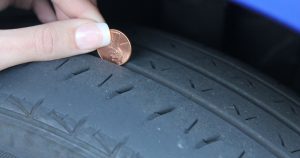 One of the most common reasons people end up stuck on the side of the road waiting for emergency roadside assistance is because something happened to their tires. Whether you had a nail in your tire or have a tire blowout, it can be stressful and sometimes frightening. If you notice where the tire wear is on your tire, you might be able to prevent further damage to your vehicle through proactive maintenance, as tire wear patterns happen for a reason. Here are some signs of tire wear to look for so you can hopefully prevent the need for emergency roadside assistance.
One of the most common reasons people end up stuck on the side of the road waiting for emergency roadside assistance is because something happened to their tires. Whether you had a nail in your tire or have a tire blowout, it can be stressful and sometimes frightening. If you notice where the tire wear is on your tire, you might be able to prevent further damage to your vehicle through proactive maintenance, as tire wear patterns happen for a reason. Here are some signs of tire wear to look for so you can hopefully prevent the need for emergency roadside assistance.
Scalloped Tires
If you see scalloped dips on the surface of your tire’s tread, this is a reason to bring your car to the auto shop for proper inspection. This could be a sign of worn suspension, shock absorbers, or unbalanced tires. If left unfixed, this can permanently damage your tire and cause you to drive without the proper suspension you need.
Inner Edge Tread Wear
If your tire is only worn on the inner edges, this can often be an easy fix. This means that the inside of your tires is wearing out faster than the rest of your tires. When you bring your car into the shop, the technician will look for the most common reasons why your tires would wear out this way. This includes negative toe and camber.
Worn Outer Edges
If your tires are mostly worn on the outer edges, this can be a sign of under inflation. Either you aren’t keeping your car’s tires to the manufacturer’s specifications for your vehicle or you keep re-inflating a tire when your tire pressure light comes on without realizing there’s a hole in your tire. Depending on the reason behind why your tire is underinflated, the technician will either need to replace or patch the tire.
Worn Out Center
If your tire is overinflated, you may wear out the center of your tire more quickly than the rest of your tire. Overinflated and underinflated tires mess with your car’s fuel economy and performance, as well as the lifespan of your tires. It is worth the time spent checking your tire pressure, especially before going on a long road trip. Some drivers are more prone to overinflated and underinflated tires when the seasons change, since air expands in the heat and condenses in the cold.
Feathered Tires
If your tires are feathered, with some tread ribs smoother on one side and sharper on the other, it might be time to get an alignment done. If your alignment is off, your tires will experience uneven wear because of where the pressure is incorrectly sitting. A simple alignment might be enough to correct it.
Fortunately, most problems that cause your tires to wear unevenly can be fixed quickly and affordably. It is important to pay attention to your tires to see if you can notice any early signs that something is amiss with your car.
Image via Pixabay



